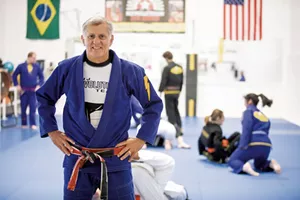
Julio César Fernandez Nunes has traded kicks, leg locks and choke holds with some of the world’s fiercest Brazilian jiu-jitsu fighters. But on a steamy afternoon in his Williston gym, the 65-year-old “Foca,” as he’s known in his native Brazil, grappled with an unexpected challenge: Two of his instructors were delayed by car troubles, so Fernandez had to single-handedly hold the attention of a dozen rambunctious 4- to 6-year-olds for nearly an hour. But the two-time Brazilian jiu-jitsu world champion was more than up to the challenge of teaching the “Ninjas” class. As the young students ambled about, each in a white pajama-like kimono, or gi, occasionally poking each other with boxing gloves almost as big as their heads, Fernandez demonstrated a playful yet firm instructional style that’s as persuasive as a half nelson. The students hadn’t lined up as quickly as Fernandez had instructed, so he chirped a brisk “Atenção!” — Portuguese for “attention.” The kids instantly fell silent and stood up, straight as rods. As they quietly awaited further instruction, Fernandez laid a rope ladder flat along the padded floor, then demonstrated the first training exercise: hopscotch-like jumps between each of the ladder rungs. As the barefoot students completed the drill with varying degrees of proficiency, Fernandez encouraged each one with a smile and an enthusiastic “Very good! Very good!” Next, Fernandez demonstrated a monkey-like crawl between the rungs of the rope ladder on his feet and knuckles, followed by a tumble at the end. He finished by slapping the mat loudly with one arm. “That’s called a shoulder roll,” Fernandez explained, in his thick Brazilian accent. “You need to learn how to fall without hitting your head.” For more than 30 years, Fernandez has been teaching students how to fall down safely — then get back up again. As the founder and owner of Vermont Brazilian Jiu-Jitsu, he’s taught hundreds of children as young as 4 how to defend themselves and subdue an opponent using techniques that don’t require superior size, strength or speed. Through this martial art — which blends elements of judo, ground fighting and Greco-Roman wrestling — students can improve their balance, flexibility and coordination while also building discipline, self-confidence, compassion and respect. “Parents see the world is very confrontational,” Fernandez explained later. “Politeness and manners are going downhill. There are a lot of bullies around. And lack of confidence makes people…
Gi Force: A Brazilian Jiu-Jitsu Master Teaches Kids to Be Confident, Safe and Strong — On and Off the Mat

